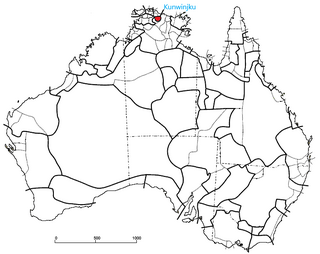
The Kunwinjku people are an Australian Aboriginal people, one of several groups within the Bininj people, who live around West Arnhem Land to the east of Darwin, Northern Territory. Kunwinjku people generally refer to themselves as "Bininj" in much the same way that Yolŋu people refer to themselves as "Yolŋu".
The Marrithiyal, also written Marithiel, are an Aboriginal Australian people whose traditional territory lay 30 to 50 miles south of the Daly River in the Northern Territory. They were sometimes known derogatively as Berringen, a term used by the Mulluk-Mulluk to refer to "aliens" or "strangers".
The Ngan'gimerri, also spelt Nangiomeri, Nanggumiri, and other variants, are an Aboriginal Australian people of the Daly River area in the Northern Territory.
The Madngella, otherwise known as the Matngala or Hermit Hill tribe, are an indigenous Australian people of the Northern Territory, Australia.
The Marranunggu are an Aboriginal Australian people and language group, of the Northern Territory.
The Mariamo or Marri ammu are an indigenous Australian people of the Northern Territory.
The Maridan were an indigenous Australian people of the Northern Territory.
The Wadjiginy, also referred to historically as the Wogait, are an indigenous Australian people of the Northern Territory, specifically from just north of modern-day Darwin. The Wadjiginy are a saltwater people who describe themselves as wagatj 'beach-dwellers' from the Batjamalh word wagatj 'beach'.
The Jamindjung, also spelt Djamindjung, are an indigenous Australian people of the Northern Territory.
The Ngaliwurru are an indigenous Australian people of the Northern Territory.
The Bilinarra, also spelt Bilingara and Bilinara, are an Aboriginal Australian people of the Northern Territory.
The Kungarakany people, also spelt Koongurrukuñ, Kungarrakany, Kungarakan and other variants, are an Aboriginal Australian people of the Northern Territory. They were called the "Paperbark People" by European settlers.
The Luritja or Loritja people, also known as Kukatja or Kukatja-Luritja, are an Aboriginal Australian people of the Northern Territory. Their traditional lands are immediately west of the Derwent River, that forms a frontier with the Arrernte people, with their lands covering some 27,000 square kilometres (10,300 sq mi). Their language is the Luritja dialect, a Western Desert language.
The Djerait were an indigenous Australian people of the Northern Territory
The Pongaponga were an indigenous Australian people of the Northern Territory. They may have been a band of the Ngolokwangga.
The Ngolokwangga are an Aboriginal Australian people of the Northern Territory.
The Mudburra, also spelt Mudbara and other variants, are an Aboriginal Australian people of the Northern Territory.
The Yunggor were an Aboriginal Australian people of the Northern Territory.
The Muringura, or Murrinh-Kura, were an indigenous Australian people of the Northern Territory.
The Wagiman, also spelt Wagoman, Wagaman, Wogeman, and other variants, are an Aboriginal Australian people of the Northern Territory.